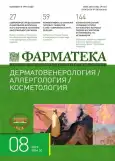Аминокислотно-заместительная терапия как подготовка и усиление эффективности коллагеностимулирующих методов
- Авторы: Свечникова Е.В.1,2, Моржанаева М.А.3, Горская А.А.4,5
-
Учреждения:
- Поликлиника № 1 УД Президента РФ
- Российский биотехнологический университет
- Клиника Skin Art
- Завод–производитель препаратов на основе PLA
- Клиника эстетической медицины O’LIVE
- Выпуск: Том 30, № 8 (2023)
- Страницы: 83-90
- Раздел: Оригинальные статьи
- Статья опубликована: 10.11.2023
- URL: https://journals.eco-vector.com/2073-4034/article/view/623096
- DOI: https://doi.org/10.18565/pharmateca.2023.8.83-90
- ID: 623096
Цитировать
Полный текст
Аннотация
Обоснование. Основной компонент дермы – коллаген, органическое соединение группы фибриллярных белков. Сосочковый слой дермы образован более мелкими пучками волокон коллагена, в нем преобладают фибробласты, фиброциты, тучные клетки, Т-лимфоциты, в то время как сетчатый слой характеризуется более крупными пучками, формирующими характерную сеть, которая обеспечивает прочность кожи, отсюда и название слоя – сетчатый. В молодой коже преобладают волокна коллагена типов I (80%) и III (15%), что составляет соотношение 6:1. С возрастом происходит уменьшение содержания коллагена типа I, что ведет к утолщению и нарушению связей между волокнами. Большинство косметологических процедур направлено на коллагеностимуляцию, однако, прежде чем стимулировать выработку коллагена, необходимо дать клеткам эссенциальные аминокислоты для синтеза коллагена типов I и III и направить воспаление по контролируемому пути. Аминокислотно-заместительная терапия (АЗТ) является основополагающим этапом при подготовке пациентов к инвазивным процедурам. В данной статье впервые для диагностики недифференцированной дисплазии соединительной ткани (нДСТ) пациентов была использована разработанная авторами «генетическая панель для диагностики нДСТ» и анкета скрининга нДСТ в косметологической практике.
Цель исследования: повышение эффективности протоколов коррекции кожи при проведении коллагеностимулирующих процедур, разработка скрининговой анкеты по выявлению нДСТ в косметологической практике, апробация генетической панели по выявлению признаков нДСТ при проведении коллагеностимуляции, разработка протоколов коррекции на основе полученных данных.
Методы. В исследование были включены три пациентки, получавшие комплексный протокол коррекции на основе полимолочной кислоты и АЗТ.
Результаты. Благодаря сочетанному применению анкеты скрининга нДСТ в косметологической практике и генетических панелей авторам удалось достичь выраженных результатов при использовании коллагеностимулирующих методов у пациентов и профилактировать возможные осложнения.
Заключение. Общие подходы к диагностике нДСТ должны быть основаны на комплексном анализе результатов клинических и лабораторных исследований. Возможности генетических панелей в сочетании со скрининговой анкетой позволяют достигать выраженных результатов и избегать возможных осложнений.
Полный текст
Об авторах
Елена Владимировна Свечникова
Поликлиника № 1 УД Президента РФ; Российский биотехнологический университет
Автор, ответственный за переписку.
Email: elene-elene@bk.ru
ORCID iD: 0000-0002-5885-4872
д.м.н., зав. отделением дерматовенерологии и косметологии; профессор кафедры кожных и венерических болезней
Россия, Москва; МоскваМ. А. Моржанаева
Клиника Skin Art
Email: elene-elene@bk.ru
ORCID iD: 0000-0001-8657-9559
Россия, Москва
А. А. Горская
Завод–производитель препаратов на основе PLA; Клиника эстетической медицины O’LIVE
Email: elene-elene@bk.ru
ORCID iD: 0000-0003-0314-7035
Республика Корея, Республика Корея; Нижний Новгород, Россия
Список литературы
- Arseni L., Lombardi A., Orioli D. From structure to phenotype: impact of collagen alterations on human health. Int J Mol Sci. 2018;19(5):1407. doi: 10.3390/ijms19051407.
- Демидов Р.О., Лапшина С.А., Якупова С.П., Мухина Р.Г. Дисплазия соединительной ткани: современные подходы к клинике, диагностике и лечению. Инновационные технологии в медицине. 2015;2(89):37–40. [Demidov R.O., Lapshina S.A., Yakupova S.P., Mukhina R.G. Connective tissue dysplasia: current approaches to the clinic, diagnosis and treatment. Innovatsionnye tekhnologii v meditsine. 2015;2(89):37–40 (In Russ.)].
- Сметанин М.Ю., Нургалиева С.Ю., Кононо-ва Н.Ю. и др. Минеральная плотность костной ткани и маркеры костного метаболизма у женщин с дисплазией соединительной ткани. Практическая медицина. 2019;17(4):102–6. [Smetanin M.Yu., Nurgalieva S.Yu., Kononova N.Yu., et al. Bone mineral density and bone turnover markers in women with connective tissue dysplasia. Prakticheskaya meditsina. 2019;17(4):102–6. (In Russ.)]. doi: 10.32000/2072-1757-2019-4-102-106.
- Ляховецкий Б.И., Глазкова Л.К., Перетолчина Т.Ф. Дисплазия соединительной ткани: роль коллагеновых белков дермы (обзор литературы). Российский журнал кожных и венерических болезней. 2012;3:19–22. [Lyakhovetsky B.I., Glazkova L.K, Peretolchina T.F. Connective tissue dysplasia: significance of dermal collagen proteins (review of literature). Rossiiskii zhurnal kozhnykh i venericheskikh boleznei. 2012;3:19–22 (In Russ.)].
- Jones M.G., Andriotis O.G., Roberts J.J., et al. Nanoscale dysregulation of collagen structure-function disrupts mechano-homeostasis and mediates pulmonary fibrosis. Elife. 2018;3(7):e36354. doi: 10.7554/eLife.36354.
- Jansen K.A., Licup A.J., Sharma A., et al. The role of network architecture in collagen mechanics. Biophys J. 2018;114(11):2665–78. doi: 10.1016/j.bpj.2018.04.043.
- Кильдиярова Р.Р., Углова Д.Ф. Ассоциированная с дисплазией соединительной ткани кардиальная патология у женщин и их новорожденных детей. Российский вестник перинатологии и педиатрии. 2015;2(60):54–6. [Kil’diyarova R.R., Uglova D.F. Associirovannaya s displaziej soedinitel’noj tkani kardial’naya patologiya u zhenshchin i ih novorozhdennyh detej (Connective tissue dysplasia-associated cardiac pathology in women and their newborns.). Rossiiskii vestnik perinatologii i pediatrii. 2015;2(60):54–6. (In Russ.)].
- Нохсорова М.А., Борисова Н.В., Аммосова А.М. Возможность диагностики недифференцированной дисплазии соединительной ткани с помощью биологических маркеров. Вестн. новых медицинских технологий. Электронное издание. 2019;4. [Nokhsorova M.A., Borisovа N.V., Ammosova A.M. Possibility of diagnostics undifferentiated connective tissue dysplasia using biological markers. J New Med Technol. E-edition. 2019;4. (In Russ.)]. URL: http://www.medtsu.tula.ru/VNMT/Bulletin/E2019-4/3-3.pdf (19.03.2021). doi: 10.24411/2075-4094-2019-1643.
- Hood L., Rowen L. The Human Genome Project: big science transforms biology and medicine. Genome Med. 2013;5(9):79.
- Ahn J.H., Noh Y.H., Um K.J., et al. Vitamin D status and vitamin D receptor gene polymorphisms are associated with pelvic floor disorders in women. J Menopausal Med. 2018;24(2):119–26. doi: 10.6118/jmm.2018.24.2.119.
- Zamborsky R., Kokavec M., Harsanyi S., et al. Developmental Dysplasia of Hip: Perspectives in Genetic Screening. Med Sci (Basel). 2019;7(4):59. doi: 10.3390/medsci7040059.
- MacFarlane E.G., Haupt J., Dietz H.C., Shore E.M. TGF-β Family Signaling in Connective Tissue and Skeletal Diseases. Cold Spring Harb Perspect. Biol. 2017;9(11):a022269. doi: 10.1101/cshperspect.a022269.
- Ritelli M., Colombi M. Molecular genetics and pathogenesis of ehlers-danlos syndrome and related connective tissue disorders. Genes (Basel). 2020;11(5):547. doi: 10.3390/genes11050547.
- Mosca M. Mixed connective tissue diseases: new aspects of clinical picture, prognosis and pathogenesis. Isr Med Assoc J. 2014; 16(11):725–26.
Дополнительные файлы












